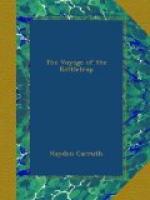On the back end we fastened a feed-box for the horses, as long as the wagon-box was wide, and ten or twelve inches square, with a partition in the middle. We put stout iron rings in the corners of this, making a place to tie the horses. On the dash-board outside we built another box, for tools. This was wedge-shaped, about five inches wide at the top, but running down to an inch or two at the bottom, and had a hinged cover. We put aboard a satchel containing the little additional clothing which we thought we should need. Things in this line which did not seem to be absolutely necessary were ruled out—indeed, for the sake of lightness we decided to take just as little of everything that we could. We made another box, some two feet long, a foot deep, and fourteen inches wide, with a hinged cover, which we called the “pantry,” for our supply of food. This we stood in the wagon with the satchel. Usually in the daytime after we started each of these rode comfortably on the bed back of the seat. This bed was a rather simple affair, made up of some bed-clothing and pillows arranged on a thick layer of hay in the bottom of the wagon-box. Our small two-wick oil-stove we put in front next to the dash-board, a lantern we hung up on one of the bows, and a big tin pail for the horses we suspended under the wagon.
“Since you’re going to be cook,” I said to Jack, “you tend to getting the dishes together.”
“They’ll be few enough,” he answered. “I don’t like to wash ’em. Tin mostly, I guess; because tin won’t break.”
So he put a few knives and forks and spoons, tin plates and cups, a frying-pan, a small copper kettle, and a few other utensils in another box, which also found a home on the bed. Other things which we did not forget were a small can of kerosene; two half-gallon jugs, one for milk and one for water; a basket for eggs; a nickel clock (we called it the chronometer); and in the tool-box a hatchet, a monkey-wrench, screw-driver, small saw, a piece of rope, one or two straps, and a few nails, screws, rivets, and similar things which might come handy in case of a wreck.
“Now for the armament and the life-boat,” said Jack.
For armament Jack contributed a double-barrelled shot-gun and a heavy forty-five-calibre repeating rifle, and I a light forty-four-calibre repeating rifle, and a big revolver of the same calibre (though using a slightly shorter cartridge), with a belt and holster. This revolver we stored in the tool-box, chiefly for use in case we were boarded by pirates, while the guns we hung in leather loops in the top of the cover. In the tool-box we put a good supply of ammunition and plenty of matches. We also each carried a match-box, a pocket compass, and a stout jack-knife.
“Now, how’s your life-boat?” asked Jack.
I led her out. She was a medium-sized brown Colorado pony, well decorated with brands, and with a white face and two white feet. She wore a big Mexican saddle and a horse-hair bridle with a silver bit.




